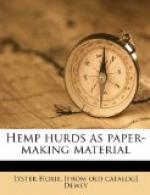=Present supplies of hurds available.=
During the last season, 1915, about 1,500 acres of hemp have been harvested outside of Kentucky and in regions where machine brakes are used. Estimating the yield of hurds at 2-1/2 tons per acre, this should give a total quantity of about 3,750 tons. Large quantities of hemp from the crop of 1914, which are still unbroken in these areas, and large piles of hurds undisturbed where the machines have been used during the last two or three years, increase the total to more than 7,000 tons. Hemp is now grown outside of Kentucky in the vicinity of McGuffey, east of Lima, Ohio; around Nappanee, Elkhart County, and near Pierceton, in Kosciusko County, Ind.; about Waupun and Brandon, Wis.; and at Rio Vista and Stockton, Cal.
In Kentucky, hemp is grown in most of the counties within a radius of 50 miles of Lexington. No accurate statistics of the acreage are collected, but the crop harvested in 1915 is estimated at 7,000 acres. A machine brake will probably be used in Bourbon County and also in Clark County, but most of the hemp in Kentucky will be broken on hand brakes.
=Baling for shipment.=
The hurds will have to be baled to facilitate handling in transportation and to economize storage space at the paper mills. The bales will need to be covered with burlap or some material to keep them from shaking out. They may be baled in the same presses that are used for baling hemp fiber, but care must be exercised to avoid breaking the press, for the hurds are more resistant than hemp fiber. A bale of hemp 2 by 3 by 4 feet weighs about 500 pounds. A bale of hurds of the same size will weigh about one-third less, or approximately six bales per ton.
Rough hemp fiber as it is shipped from the farm is not covered; therefore, the covering material must be purchased especially for the hurds. A piece of burlap about 36 by 48 inches placed on either side of the bale will be sufficient, but these pieces, weighing about 3 pounds each, cost about 40 cents a pair. Baling rope, in addition to jute covering, will cost at least 5 cents per bale, making the total cost of covering and ties $2.70 or more per ton. Possibly chip-board, costing about $33 per ton, or not more than 5 cents for the two pieces for each bale, may be used in place of burlap. Chip-board, burlap, and also rope ties may all be used for paper stock. Burlap covers might be returned, to be used repeatedly until worn out, but chip-board could not be used more than once.
=Cost of baling.=
If burlap covers are used the cost of baling, including covering, ties, use of baling press, power, and labor will amount to at least 60 cents per bale, or about $3.75 per ton. If chip-board can be used the cost may be reduced to about $2 per ton. The cost of hauling and loading on the cars will vary from $1 to $3 per ton, depending upon the distance and the roads. The farmer must therefore receive from $4 to $6 per ton for the hurds, baled, on board cars at his home station.




